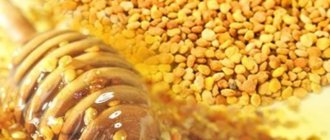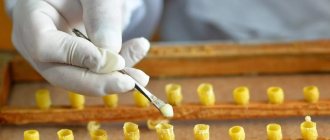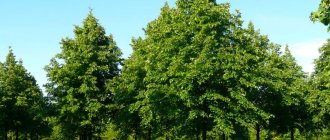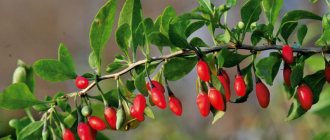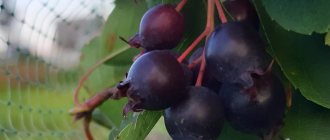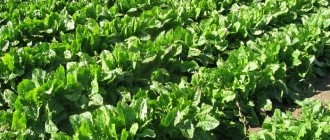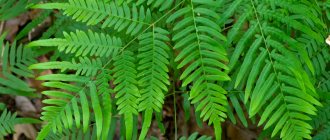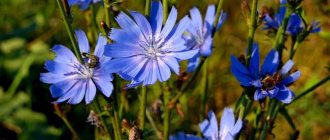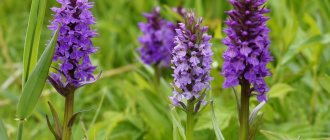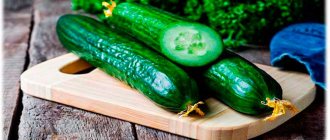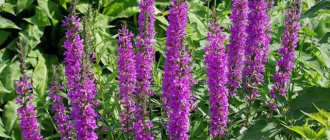Pine is a beautiful tree, but its flowers are so inconspicuous that it would hardly occur to anyone to pick them into bouquets. But in terms of usefulness, pine flowers, and the whole tree as a whole, are valued very highly. You could say it contains an entire forest pharmacy. Cones, needles, branches, buds, bark, resin, flowers, and especially pollen have beneficial properties. It’s not for nothing that during the flowering period whole swarms of bees fly over the pine trees. Smart insects strive to prepare as much as possible of the valuable food product needed to feed all the inhabitants of the hive. Healers have long paid attention to the behavior of bees and began to find out what beneficial properties pine pollen has, how to take it for health benefits, and what can be cured with it. They continue to study this natural product even now. We offer you information about it, verified by numerous experiences and experiments.
Pine inflorescences
Surprisingly, some people do not even know that coniferous trees can bloom, and they think that the cones appear directly from the branches. In fact, conifers have flowers, and on one tree, in close proximity to each other, two types of them “bloom” at once - male and female. Pine pollen, the use of which for medicinal purposes has been known for centuries, is found only in male flowers, scientifically called microstrobilae.
Usually they are located in several pieces (less often one at a time) at the very tips of the branches and resemble light brown, sometimes yellowish-beige spikelets or miniature cones up to a maximum length of 15 mm. It is in these microstrobili that pollen grains ripen. They are round, but have two air sacs on the sides, thanks to which the wind or water carries them for many kilometers. To collect pollen, you need to know exactly the time of pine flowering, otherwise the valuable medicinal product from the microstrobiles will spill out. In each region, dates may differ, and pine trees, although similar in appearance, may belong to different species and varieties and have different flowering periods. But everywhere they come before the greening of deciduous trees and bushes. In the Moscow region this is the second half of May.
Collection
Flowering is a biological process that allows a tree to develop. In spring, the plant produces buds of both male and female types, but the gifts of nature are contained only in male buds. Under a microscope, pollen looks like round-shaped grains protected by a very dense shell. When flowering ends, microparticles are spread to nearby trees, which ensures the process of fertilization of female buds on nearby trees.
You can collect useful raw materials yourself if there is a clean forest nearby where pine trees grow. It is very important to collect pine pollen in ecologically clean regions, where there are no nearby industrial giants whose work pollutes the environment, or highways along which a huge amount of toxic substances settle.
Pine flowering occurs in the second half of May and lasts about five days. Therefore, before collecting pollen, it is important to take care not to miss the right time. It is important to take into account that the collection is carried out in dry, not rainy weather. These should be sunny, dry days. If it is cloudy, due to high humidity, the tree buds are tightly closed, so the lightest, almost weightless substance cannot be shaken off the branches.
For collection, you will need paper bags, since the smallest particles stick to the fabric, you should not use them. Having selected a branch, bend it so that it is immersed in the bag and shake it slightly so that the microparticles fall into the bag.
If you need to make preparations of not only flowering elements, but also other parts of this amazing plant, the buds are carefully cut off and placed in a paper bag. Using filters, you can easily separate the lightest particles from other elements, so you get shoots and needles, which can be used to prepare various preparations that have a healing effect.
Chemical composition
What are the benefits of pine pollen? The use of this natural product determines its rich composition. Each speck of dust contains proteins, fats, glycine, organic acids, proline, rutin, threonine, testosterone (especially high content in Scotch pine pollen), flavonoids, and enzymes. Vitamins A, groups B, D3, C were found in the pollen, and in addition, trace elements potassium, selenium, manganese, iron, zinc, calcium, magnesium, copper, phosphorus - about 30 minerals in total. This is an incomplete list of substances and their compounds that make pine pollen so valuable.
For men
Thanks to the content of the mentioned hormonal compounds, pine pollen extract can be used to increase testosterone levels within minutes.
For this reason, the natural product is popular among middle-aged men. Its use is a great way to maintain optimal testosterone levels and physical performance.
To support natural testosterone production for men, it is recommended to take pollen in the morning, before or after physical activity and before bed. For best results, use this natural remedy 2-3 times a day.
The healing properties of pine pollen include the amino acid arginine, which increases nitric oxide levels, which helps increase blood flow to the genitals. Arginine stimulates growth hormone, promotes fertility and sperm production.
Article for you:
Tibetan milk mushroom: beneficial properties and contraindications, how to care for, prepare and consume for health benefits
The phytohormone gibberellins, which belongs to the group of plant hormones, regulates the size of the prostate, maintains its health and helps treat diseases.
Contraindications
No matter how valuable the pine forest pharmacy is, not everyone can use it. During the flowering period of coniferous trees in places where they grow in large quantities, some people experience allergy symptoms (runny nose, conjunctivitis, cough and others). For those whose body reacts to pine pollen in this way, taking preparations from it orally is contraindicated. In addition, this medicine is not suitable for those suffering from renal and heart failure, pregnant women, infants, and people with individual intolerance.
Pine pollen: how to collect
In principle, preparing pollen is not difficult. The main thing to keep in mind is the timing of flowering. Mature pollen spills out of male microstrobilae quickly and easily. The wind shaking the branches also contributes to this. Therefore, the collection of the product must begin when the male inflorescences have already reached the required (mature) size, the dust particles in them have already matured, but the microstrobiles have not yet opened. Nature allocates only 2, maximum 5 days for this process. There are collectors who simply pour pollen from flowers into a prepared container, such as a plastic bag, shaking them or lightly tapping them with a finger. In this case, the flowers remain on the branches.
This method is gentle on the tree, but ineffective, although the result is that the bag contains naturally ripened pine pollen.
Experienced harvesters know how to assemble it more efficiently. They determine when it is time to start the process by the color of the male strobile cones, which should turn bright yellow, sometimes with a greenish tint. The inflorescences are carefully cut from the branch and placed in a container covered with clean paper. Some small percentage of pollen spills out, but it will not disappear.
The inflorescences are laid out to dry, the pollen is shaken out of them, sifted through a sieve with a very fine mesh and packed in sealed jars. It is advisable to sift the pollen 3-4 times, placing a plastic bag under the sieve. As a result, the product should be purely yellow, without brown impurities. There should be no drafts, much less wind, in the room where pollen is manipulated. The yield of raw materials is small. Usually you get a glass or one and a half of pure pollen from a bucket of inflorescences.
May have anti-cancer properties
Bee pollen may have uses in the treatment and prevention of cancer, which develops as a result of abnormal proliferation of body cells.
Test-tube studies found that bee pollen extract inhibited tumor growth and stimulated apoptosis (programmed cell death) in prostate, colon, and leukemia cancers (23, 24).
Bee pollen derived from cistus (Cistus incanus L.) and white willow (Salix alba L.) may have antiestrogenic properties, which may reduce the risk of breast, prostate, and uterine cancer (25, 26).
However, human studies are needed.
Summary:
Test-tube studies suggest bee pollen reduces the risk of several types of cancer, although human studies are needed.
The easiest way to treat
Traditional healers, especially in China, are well aware of the beneficial properties of pine pollen. We will now tell you how to take it, and most importantly, how to prepare preparations from it. You can use pollen as a kind of dietary supplement, that is, add it to your diet. For adults, the dose is half a teaspoon or a little less half an hour before each meal. You can take this medicine with water, tea or milk. The course lasts one month, after which you need to take a break, since long-term consumption of pollen can change blood clotting. Dry pollen is taken as a preventive medicine for colds in the off-season, as a means to strengthen the body after operations or serious illnesses, as a means of controlling metabolic processes and thereby removing excess weight, as well as to slow down the aging process.
Tinctures
There are methods for making potions in which pine pollen exhibits beneficial properties to a greater extent. How to take these drugs and how to prepare them? The main of these folk remedies are tinctures. They are considered a powerful biostimulant that renews cells and restores all bioactive processes in the body. This gives excellent results as a comprehensive treatment for cancer, tuberculosis, infertility, diseases of the stomach, liver, kidneys, lungs, rejuvenation of the body, restoration of the nervous system, improved sleep, relieving fatigue, and increasing immunity. A tincture is prepared not from pollen alone, but also from anthers (ripe male pine flowers), in proportions of approximately 1:2. Fill the jar 2/3 full with this raw material and fill it to the top with vodka. Leave for 2 days or more, then filter and place in the refrigerator.
To prevent any diseases, to improve tone, to relieve fatigue and to strengthen the body, drink the tincture once a day, a teaspoon half an hour before meals. As a remedy for oncology, asthma, tuberculosis, drink the tincture three times a day, a tablespoon or a dessert spoon, also half an hour before meals. The course is no more than a month, after which a break is needed. It is very useful to add pollen tincture to herbal teas, for example, when coughing with phlegm, to decoctions of coltsfoot, lungwort, plantain, thyme, and rosehip. For dry cough - in decoctions of marshmallow, buckwheat, chamomile, hazelnut leaves, sunflower petals.
Application area
In folk medicine, the medicinal properties of pollen allow it to be used in the treatment of the following diseases:
- acute viral pathologies of the respiratory tract;
- tuberculosis, pneumonia;
- diabetes;
- pancreatic diseases;
- acute and chronic diseases of the gastrointestinal tract;
- pathologies of the reproductive and urinary systems in women and men: orchitis, urethritis, prostatitis, epididymitis, prostate adenoma;
- inflammation of various etiologies;
- oncological neoplasms;
- hormonal disbalance;
- menstrual irregularities;
- menopause;
- hypertension;
- bleeding;
- phlebeurysm.
We recommend that you read Recipes for deep-fried avocado
Pollen is used in cosmetology. Based on it, products are prepared to help cope with freckles, age spots, acne and blackheads. This product restores skin elasticity and helps smooth out shallow expression and age wrinkles.
In oncology, the substance affects only cancer cells, inhibiting biochemical processes in them and slowing down the process of their division.
For prevention purposes, pollen is recommended to be taken by people who have a hereditary predisposition to cancer.
Infusions of water and milk
You can get a lot of advice from traditional healers on how to use pine pollen. There are also recipes for decoctions. They are simple, but you need to remember that you cannot boil pollen, because at temperatures above 90 degrees many useful substances disappear from it. The easiest way is to brew pollen with milk (a teaspoon per glass). The milk is brought to the boiling point and removed from the heat, pollen is added in a thin stream, mixed, wrapped and left to infuse. You can add honey to this medicine. They drink milk with pollen for tuberculosis, bronchitis, various hormonal disorders, stress and fatigue, and a weakened body.
There is a separate recipe for preparing medicine from pollen and milk for hypertension. Take a glass of unboiled milk, add pollen on the tip of a knife, mix and drink every morning an hour before the meal.
For bronchitis, you can brew not only pollen in milk, but also male pine inflorescences.
You need to prepare pollen decoctions in water (you can use herbs) without boiling, only in a water bath.
There is a good recipe for making syrup from pollen and male pine inflorescences. To do this, boil 300 grams of sugar in one and a half glasses of water. Pour 500 grams of raw material into the finished syrup, press down with a light weight and leave to cool. Next, it is filtered, and the syrup is used as a preventive medicine, to treat asthma and strengthen the body, and pine inflorescences are added to teas as needed.
Pine pollen with honey
This is the most effective method of treatment. The product is prepared as follows: add a tablespoon (without a slide) or one and a half dessert spoons of pollen to 500 grams of honey and mix the mass until smooth. It should turn out a beautiful yellow-golden color. Before use, it is advisable to melt the candied honey in a water bath or place it on a radiator. This medicine can be eaten for absolutely all diseases by those who are not allergic to bee products. Pollen with honey is especially often used for colds, bronchitis, laryngitis, and tonsillitis. Adults take 2 teaspoons three times a day, and children over 6 years old take one teaspoon.
